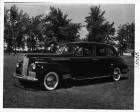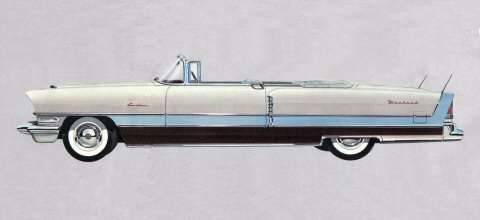|
Re: Camber alignment
|
||||
|---|---|---|---|---|
|
Home away from home
|
The 51 manual gives positive camber as more space at the top.
Cars with modern radial tires pretty much always have negative camber as that makes the tire contact patch larger on the outboard wheel when going through a turn. However, positive camber has the advantage of that the contact patch grows as the car is loaded and the suspension compressed. The relevance of these considerations is highly dependent on the suspension design. For the same reason as the 3rd paragraph, when going through a turn, the contact patch may be increased on the outer tire, giving the same effect as the 2nd paragraph. It's a balance of tire dynamics and control arm design which determine the optimal settings. Car manufacturers will literally just pull a car in different directions when stationary to study the reaction of the suspension system and thus calculate an optimal design and settings. So I would interpret that as positive camber. That was the standard of the day.
Posted on: 6/22 17:15
|
|||
|
1955 400 | Registry | Project Blog
1955 Clipper Deluxe | Registry | Project Blog 1955 Clipper Super Panama | Registry Email (Parts/service inquiries only, please. Post all questions on the forum.) service@ultramatic.info |
||||
|
||||
|
Re: Camber alignment
|
||||
|---|---|---|---|---|
|
Webmaster
|
The alignment information can be found in the Service Counselor/Letters section under specifications.
Here is one that lists the compiled information from the mid-1930s through 1942, which I retrieved using the Service Index on the left-hand menu. 
Posted on: 6/22 21:55
|
|||
|
-BigKev
1954 Packard Clipper Deluxe Touring Sedan -> Registry | Project Blog 1937 Packard 115-C Convertible Coupe -> Registry | Project Blog |
||||
|
||||
|
Re: Camber alignment
|
||||
|---|---|---|---|---|
|
Home away from home
|
Industry standard convention is that positive camber means the wheels are tilted out at the top. Likewise, positive caster means that the king pin is tilted to the rear at its top--just like a fork on a bicycle.
Posted on: 6/23 6:44
|
|||
|
||||
|
Re: Camber alignment
|
||||
|---|---|---|---|---|
|
Home away from home
|
Quote:
Pgh Ultra (sounds like a James Bond villain) provides a learned discussion of WHY, not just what...this helps when you are doing the camber adjustment so you know what symptoms to look out for when doing your run-in test. Also, Ross' discussion on caster (often overlooked) gets at front wheel stability (or sometimes dynamic resonance/vibration/wobble)...generally positive caster allows the tire contact point to trail the kingpin with the contact surface of the ground "pushing up" behind the kingpin line of action as it intersects the ground, thus more easily damping out oscillations/vibrations in the combined steering system and suspension to mitigate coupling of the complex dynamics of all of this equipment's elastic response (think of each system as a group of very stiff springs tuned to different frequencies); however, increased steering force is required. If you have negative caster, the tire's ground contact surface is in front of the kingpin line of action intersection at the ground and the stability margin/damping is reduced so oscillations of the wheel can be triggered more easily by bumps at different speeds and the steering force is minimal; bumps/oscillations from the driver can create "dutch roll" and induce oscillations; not good. Neutral caster has marginal stability and the closer you go from Positive-towards-Neutral, oscillation damping requires a cross-damper/stabilizer to aid in damping (mini shock absorber on the cross linkage often seen on trucks) ...all of this is a similar stability principal in an aircraft, arrow, projectile being stable with the center of pressure behind the center of mass (or in this case the center of force at that kingpin)
Posted on: 6/23 8:24
|
|||
|
||||
|
Re: Camber alignment
|
||||
|---|---|---|---|---|
|
Home away from home
|
Thanks DM37, glad you liked my response. Your tips on caster are good, but it's negative caster that allows the wheels to trail the kingpin, and vice-versa.
It's worth noting that setting the caster wrong will give bizarre steering that's either far too hard or too easy. In the days before power steering, it was a learned skill to set these things properly where the car was easy to steer yet the steering would self-center and the overall feel was good and predictable. Now with power steering, a positive caster of about 4 degrees is nearly universal as the car will self-center predictably (steering with positive caster will lift the car when the wheel is turned to one side). Sometimes shops will set an old car caster like a new car, making the steering very tough.
Posted on: 6/23 9:36
|
|||
|
1955 400 | Registry | Project Blog
1955 Clipper Deluxe | Registry | Project Blog 1955 Clipper Super Panama | Registry Email (Parts/service inquiries only, please. Post all questions on the forum.) service@ultramatic.info |
||||
|
||||
|
Re: Camber alignment
|
||||
|---|---|---|---|---|
|
Home away from home
|
Knuckle pin angle, which I believe is also referred to as kingpin angle, is the inboard slant of the king pins. It also contributes to steering stability. Vehicles with near 0 specified caster will probably have more kingpin inclination. Caster and camber are related, and where more positive caster (rearward slant of king pins) is indicated, more positive camber is usually needed, and perhaps a little more toe in as well. On a 110 or 120, I'd look for 1 to 1 1/4 degrees of positive camber, 2 1/2 degrees of caster, and about 1/8" toe in. The kingpin inclination should be OK if no parts are bent. More positive caster, within reason, will give more tracking stability, with a slight increase in steering effort at low speeds. Incorrect toe in will cause rapid tire wear. No steering system will work properly with worn or bent parts, and proper shock absorber action is essential for the car to ride and handle as it should. Factory specs for steering angles assume the system is in good condition and that the springs are also in good condition. Worn or mis-matched tires will degrade steering action, and tire inflation has a substantial effect on ride and handling. Factory tire inflation specs for the late 1930s cars are very low, like 22 PSI for the 110 and 120 coupes. I run 24 to 26 PSI, cold, on my '37 120 conv. coupe with original type and size bias 4 ply tires.
Posted on: 6/23 10:08
|
|||
|
||||
|
Re: Camber alignment
|
||||
|---|---|---|---|---|
|
Home away from home
|
Quote:
Pgh: I was correct. I amended my text a tad to reinforce what I was saying, which is tire CONTACT point behind the kingpin LINE OF ACTION intersection AT THE GROUND denotes positive stability and therefore the term “positive” caster. Is that clearer?
Posted on: 6/23 11:19
|
|||
|
||||
|
Re: Camber alignment
|
||||
|---|---|---|---|---|
|
Home away from home
|
Quote:
Ok, I get what you are saying now. For everyone else, what he said (to restate) is that positive caster gives the contact patch (red dot) behind the where the kingpin line of action intersects the ground (red arrow). I was saying that the wheel center is in front of the center of the kingpin (blue arrow). The two descriptions are equivalent. 
Posted on: 6/23 12:34
|
|||
|
1955 400 | Registry | Project Blog
1955 Clipper Deluxe | Registry | Project Blog 1955 Clipper Super Panama | Registry Email (Parts/service inquiries only, please. Post all questions on the forum.) service@ultramatic.info |
||||
|
||||
|
Re: Camber alignment
|
||||
|---|---|---|---|---|
|
Just can't stay away

|
Thank you all, your knowledge always is invaluable to us home mechanics.
Posted on: 6/23 20:47
|
|||
|
||||








